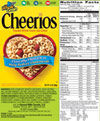Supermarket strategies for the holiday season.
(Every season for that matter.)
12/06/2007
Furci Home / Fitness Channel / Bullz-Eye Home
A column by Mike Furci that brings you research, trends and other info to help you with your fitness, health and nutritional needs.
Good nutrition starts with a trip to the grocery store. Unfortunately, even those with the best intensions for healthy shopping unknowingly leave the store with a cart loaded with garbage. This is no surprise when you consider all the mass marketing you are inundated with on a daily basis. All of this information, or misinformation, can make it a challenge to buy the right foods or products with healthy ingredients to cook healthy meals.
Who has the time to read ingredient labels and compare prices for the best deals? And who knows how to pronounce the words on the labels, let alone know what they are? Are some of the ingredients in foods we buy every day detrimental to our health? What about the ads touting how healthy and nutritious some products are? Doesn’t the Food and Drug Administration oversee food safety? Should we be skeptical? You’re right: shopping is not an easy task. It can be overwhelming for the average consumer, not only because of the mass media, but because there are so many choices.
Supermarkets perform a tremendous service by offering tens of thousands of products. Nevertheless, you need to be aware that they are designed to entice you to buy more, with no consideration to your health. And judging by the health of our nation people are definitely buying the wrong products and eating more of them. However, with a little knowledge and guidance, healthy and delicious choices are easy to make.
An empty stomach equals disaster
Never, ever go grocery shopping on an empty stomach. This is by far the worst thing you can do to sabotage your shopping. When you’re hungry, everything looks and smells good. And worse, your ability to make good choices greatly diminishes, if not disappears all together. If you’re hungry, eat first and then shop later when you’re less vulnerable to impulse buying.
Make a list
Studies have shown a shopping list will save the average shopper 10 percent. Make the list according to the layout of your grocery store so you’re not wandering around. This is another great way to avoid impulse purchases.
Go solo
If you’re able, leave the kids at home. If you have no other choice but to take your kids, many grocery stores have put in small play centers that allow parents to shop by themselves. Studies show most parents can’t say no to their kids and spend 10 to 40 percent more with them along. Without kids you’re less likely to spend your hard earned money on junk that you and your family doesn’t need.
Make healthy choices
Processed foods or convenience foods are a no-no. The U.S. Department of Agriculture notes that preparing whole food from scratch allows you take control of its taste and your health. Wow! The Department of Agriculture has really gone out on a limb on this one. Consuming whole foods is healthier for you than processed foods!?!? As simple as that concept is, most people just don’t get it, and/or are just too damn lazy to care. The food industry has tapped into an almost irresistible part of the human psyche with convenience foods.
Many people would rather throw a processed, precooked meal in the microwave or oven than take 30 minutes to prepare it themselves. I hear excuses like, “I just don’t have the time” or “I work 10 hours a day.” The way I see it, the people of this country don’t have a choice. With obesity and its associated diseases spiraling out of control, people need to care about what they and their children consume on a daily basis. The more processed a food is, the more garbage it has in it. Get off your lazy duff and start preparing your own foods using whole natural ingredients.
Stay on the perimeter
All the unhealthy, processed foods tend to be toward the center of the store, which is true at a micro market or a super market. Fresh produce, meats, dairy and other healthy foods are on the perimeter. Staying away from the center aisles will help curb temptation from junk and convenience foods and impulse buying.
Labels
Reading food labels is a must. You cannot go by the ads you see on TV and in magazines, touting how “healthy” a company’s product is. Ingredients used for filler, flavoring and preservation -- although FDA approved -- are literally poisonous and wreak havoc on our bodies. Reading food labels is the only way to see for yourself what is in the product you’re buying, to judge if in fact it is nutritious.
The following are a few examples of products that -- on the surface -- seem similar in nutrition until you read the labels.
Ice cream: Breyers vs. Edy’s

Ingredients: Milk, Cream, Sugar, Natural Flavor, Natural Tara Gum

Ingredients: Milk, Cream, Sugar, Skim Milk, Corn Syrup, Natural Flavor, Cellulose Gum, Mono and Diglycerides, Ground Vanilla Beans, Guar Gum, Carrageenan, Dextrose
Edy’s contains 5 more ingredients than Breyers. Two of them are sugars and another is mono and diglycerides, which are emulsifiers made from soy and vegetable oils. Vegetable oil bi-products in ice cream? Are all these extra ingredients really necessary? It’s ice cream for God’s sake!
Cereal: Cheerios vs. Fruit & Bran

Ingredients: Whole Grain Oats, Modified Corn Starch, Corn Starch, Sugar, Salt, Tocopherols, Trisodium Phosphate, Calcium Carbonate, Natural Color. Contains Wheat Ingredients
Cheerios has only 1g of sugar per 30g serving. There are no artificial colors or flavors.

Ingredients: Whole Grain Wheat, Wheat Bran, Sugar, Raisins, Rolled Oats, Dates, Rice, Brown Sugar, Partially Hydrogenated Vegetable Oil (Sunflower and/or Canola Oil), Walnuts, Corn Syrup, Rice Flour, Salt, Wheat Flour, Malted Barley Flour, Corn, Whey (from Milk), Malted Corn and Barley Syrup, Caramel Color, BHT (added to preserve freshness). Vitamins and Minerals
Fruit & Bran has more than seven times the amount of sugar per serving than Cheerios. You’ll notice from the ingredient list, sugar is the third, eighth and 11th ingredient, while partially hydrogenated vegetable oil, which contains trans fat, is the ninth. This cereal also contains BHT.
Ads for Fruit & Bran read, “In fact, studies show that high fiber foods like Post Fruit & Bran may help lower the risk of heart disease as part of a diet low in saturated fat and cholesterol.” While touting the health of their cereal, they neglect to add it’s loaded with sugar and contains trans fat, both of which increase your risk of several diseases including heart disease. Food labels as well as ads can be deceptive.
As you should be starting to notice, there are many things to look for when reading food labels. The following are some practical tips to help you make healthy choices:
- Read the entire label including the nutritional facts and the ingredient list.
- Ingredients are listed in descending order by weight. Ingredients in the largest amounts are listed first.
- Avoid products that contain trans fats. You’ll find trans fats listed in the Nutritional Facts section under total fats. Buyer beware! According to the new label laws started in January 2006, a product that contains a half gram of trans fat or less per serving is allowed to list trans fat as “zero” in the Nutritional Facts section. Many products also use this loophole to advertise zero trans fat on the front of the package. This is why it is so important that you read the ingredients list, although you won’t find trans fat listed. See the next item.
- Avoid products that contain “shortening,” “partially hydrogenated vegetable oil” or “hydrogenated vegetable oil” in the ingredients. They all contain trans fat. Warning: Trans fats are produced through the process of hydrogenation. This process turns polyunsaturated oils into fats that are solid at room temperature, that are then used in thousands of products. To produce them, manufacturers begin with the cheapest oils including soy, corn, cottonseed and canola. The dangers of these man-made fats have been known for decades.
- Try to avoid products that contain polyunsaturated fats. These fats include; corn oil, soy oil, safflower oil, sunflower oil, cotton seed oil, walnuts, flax oil and hemp oil. One of the biggest reasons polyunsaturated fats are so unhealthy is because they are very susceptible to becoming oxidized or rancid when exposed to heat and light. These oils contain extremely high levels of free radicals. The polyunsaturated oils (vegetable oil) sold on store shelves or contained in the processed food you buy in grocery stores are already rancid.
- Try to choose products that contain coconut, palm, palm kernel or animal fats.
- Only choose oils that are labeled “Cold Pressed,” “Expeller Pressed” or “Extra Virgin.”
- Do not choose oils that are exposed to light. Avoid clear containers.
- Avoid foods that contain monosodium glutamate or MSG. WARNING: It’s been observed in many studies that animals fed MSG became morbidly obese. This phenomenon is so reproducible, it is the method scientists use to produce obese animals in doing obesity research. MSG has also been linked to a whole host of degenerative disorders. But federal label laws make it difficult to spot MSG. Any food containing less than 99 percent pure MSG can be labeled by it’s common name; soy protein, soy protein isolate, stock, broth, vegetable protein and more. Why is the glutamate industry opposed to letting consumers know where MSG is hidden? I think the answer is obvious.
- Avoid foods that contain fructose.
- When comparing like products, make sure the serving sizes are the same or similar.
- A serving size does not usually reflect how much of the product you will normally eat. In fact, most eat quite a bit more than the listed serving size.
- When trying to choose foods high in fiber, ingredients like “enriched wheat,” “stone ground wheat,” “nutra-grain” or “seven grain” are very deceptive. Unless the word “whole” appears in the ingredient, the product is lacking nutrients, including fiber.
- When shopping for organic foods, look for the green and white label that reads USDA Organic.
- Avoid processed foods as much as possible.
All it takes is a little planning and effort. Follow the above and eat more nutritiously. Remember, the farther a food is from its natural state, the worse it is for us.
Have a question for Mike? Send it to mike@bullz-eye.com.
You can follow us on Twitter and Facebook for content updates. Also, sign up for our email list for weekly updates and check us out on Google+ as well.













